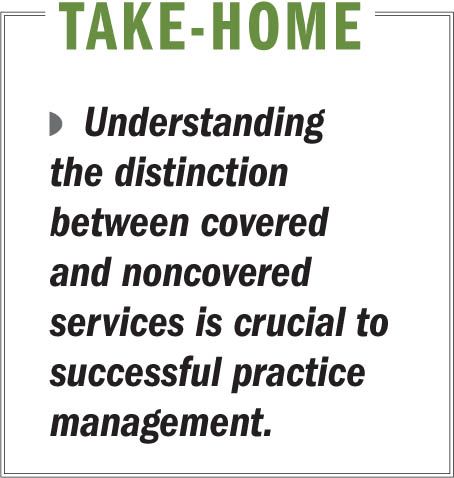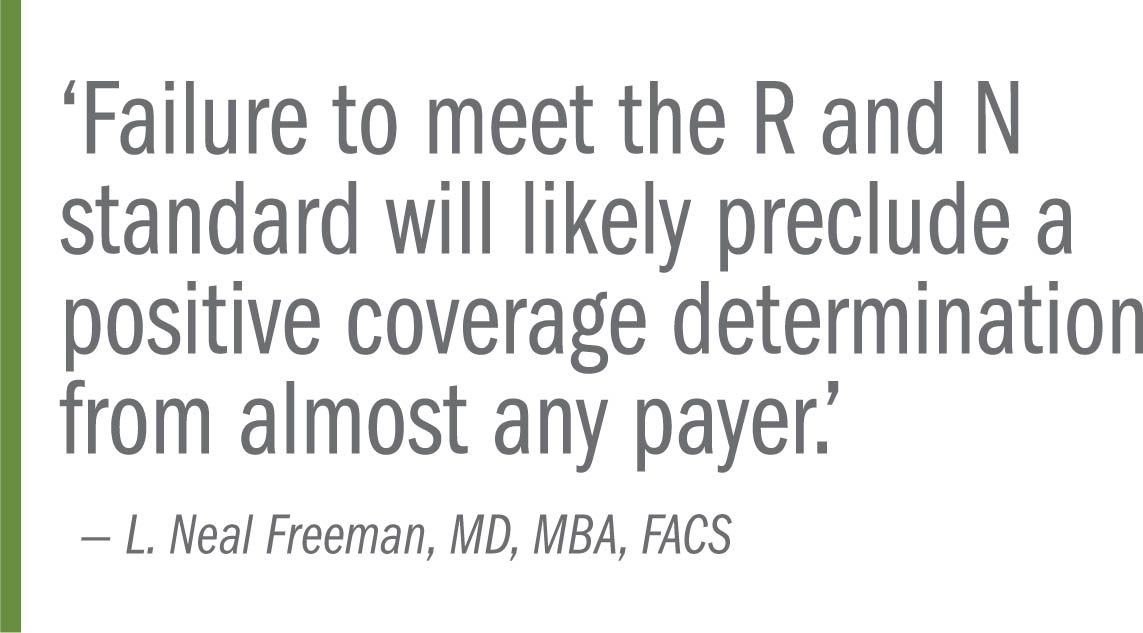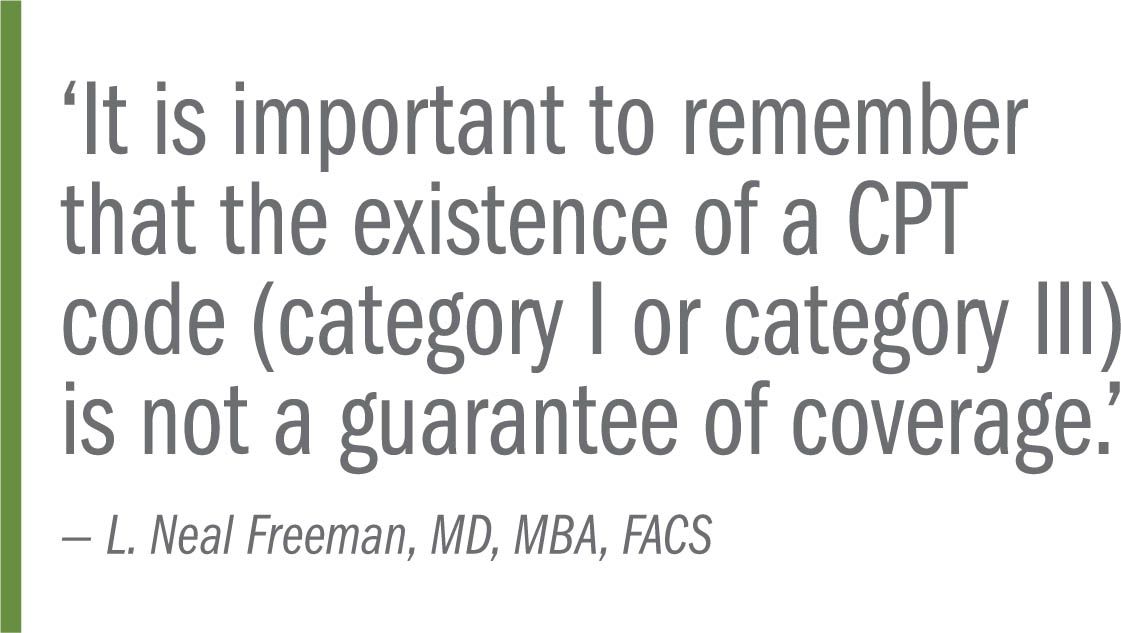Article
How payer perspective guides reimbursement
Understanding the distinction between covered and non-covered services is vital to successful practice management.
coding.doc by L. Neal Freeman, MD, MBA
Doctors are quite accustomed to hearing the question, sometimes several times a day, “Will insurance pay for it?” The correct answer often depends on coverage. A clear understanding of the distinction between covered and non-covered services is vital to successful practice management. This area is especially crucial to device manufacturers, as the success or failure of their product may hinge on coverage determinations.

Fortunately, there is considerable information about this topic throughout the Medicare literature. Private payers include references to covered versus noncovered services in their policies as well. Although private payers’ approaches often mirror those of Medicare, differences may occur.
Practice management: Legal tips to avoid a lawsuit from knocking on your door
This is a broad ranging concept impacting all specialties. In ophthalmology, coverage is highly relevant to many conditions including cataract, glaucoma, macular degeneration, eyelid pathology, and dry eye syndrome. Coverage also affects testing services.
Medicare applies these criteria when determining if a service or item is covered: The service must fit within a defined benefit category, must be medically reasonable and necessary, and must not be excluded from coverage. Some services (such as routine eye exams) are excluded from coverage by statute. Others are excluded based on policy considerations determined either locally or nationally. Local Coverage Determinations (LCDs) express policy determinations by local medical carriers, and far outnumber National Coverage Determinations which serve a similar function on a national basis.
Pay off debt or invest my money: What is the right way to go?
The medically reasonable and necessary (“R and N”) standard can be understood by reviewing this definition:
"Medical necessity is defined as the need for an item(s) or service(s) to be reasonable and necessary for the diagnosis or treatment of disease, injury or defect. The need for the item or service must be clearly documented in the patient’s medical record. Medically necessary services or items are: appropriate for the symptoms and diagnosis or treatment of the patient’s condition, illness, disease or injury; and provided for the diagnosis or the direct care of the patient’s condition, illness, disease or injury; and in accordance with current standards of good medical practice; and not primarily for the convenience of the patient."
Economic requirements
Physicians also recognize the increasing occurrence of economic requirements that various payers place in contracts, such as:
“(The service is) … the most appropriate service(s), rendered in the most efficient and [and economical way and not more costly] than an alternative service or sequence of services at least as likely to produce equivalent therapeutic or diagnostic results as to the diagnosis or treatment of the patient’s illness, injury or disease.”

Blog: Keys to finding balance in a successful practice
Failure to meet the R and N standard will likely preclude a positive coverage determination from almost any payer.
Payers look to peer-reviewed literature when making decisions on coverage, but often rely on opinions from experts in the field of interest. Testimonial endorsements are not generally considered.
Some Medicare carriers and private payers produce lists of “noncovered services.” The large Medicare carrier Noridian, for example, has issued a Local Coverage Determination of noncovered services that lists procedures in each of these categories:
Putting it in view: 4 secrets to sustaining success in your practice
Group 1: Services that are not covered due to being investigational/experimental, not proven effective or are not reasonable and necessary.
(All new Category III Codes, unless specifically approved for payment by CMS or the Noridian Medical Directors and listed as approved in our article, are non-covered.)
This list includes procedures such as CPT 92145, corneal hysteresis determination by air impulse stimulation, and suprachoroidial delivery of pharmacologic agent.
Group 2: Components of Another Service, Never Separately Billable to the Contractor or the Patient
This list includes procedures such as CPT 95060 Schirmer tests (ophthalmic mucous membrane tests), and suture removal (when billed by same provider).
Group 3: Statutorily Non-covered Service, the Patient is Liable for Payment
Codes in this list include astigmatic keratotomy, and CPT 0380T Computer-aided animation and analysis of time series retinal images for the monitoring of disease progression.
First Coast Service Options in Florida has a similar LCD entitled “Noncovered Services.” Included on this list are CPT 15820 and 15821 (lower eyelid blepharoplasty surgery).
Practice management: Is the smartwatch ready for your practice?
Many of the noncovered services on various lists are Category III (investigational) CPT codes, but some are full-fledged Category I CPT codes, as noted above (e.g., CPT 95060, 15820, 15821).
Recipes for noncoverage
Harvard Pilgrim is a private payer with a specifically-defined policy on noncovered services that includes this language:
"Experimental or Investigational Procedures--Services or procedures that are experimental, unproven, or investigational and not supported by evidence based medicine and established peer reviewed scientific data are not covered.”
Note that this guideline is essentially the same as referenced in the Noridian LCD above.
Recent: Flying Eye Hospital aims to prevent blindness worldwide

Payers often cover a variety of services performed by non-physicians. The coverage tends to be specific to the payer. For example, Medicare indicates that some services are covered for a list including physician assistants, nurse practitioners, and occupational and physical therapists.
In particular circumstances, screening exams are covered. Medicare covers screening exams for diabetes and glaucoma in eligible individuals. Diagnostic tests are covered under specific instances. There is often detailed information available regarding diagnostic testing and relevant diagnoses.

Ophthalmologists weigh in: Timing of Olympics and Zika spurs debate
Recipes for noncoverage include exceeding frequency guidelines, mismatch between the listed diagnosis and the item or service provided (poor “cross coding”), and inadequate documentation. It is important to remember that the existence of a CPT code (category I or category III) is not a guarantee of coverage.
A sophisticated understanding of the coverage process will benefit doctors, billers, and patients. It is a very worthwhile area to investigate and master.
Newsletter
Don’t miss out—get Ophthalmology Times updates on the latest clinical advancements and expert interviews, straight to your inbox.




